Celeriac Latkes
Celeriac Latkes, or pancakes if you prefer, are a great alternative to the traditional potato version.
Grated celeriac is mixed with onion, eggs, flour, seasoning, and griddled or fried until golden brown. This sweetens celeriac’s subtle celery-parsley-like flavour to make a delicious appetizer, snack or side dish.
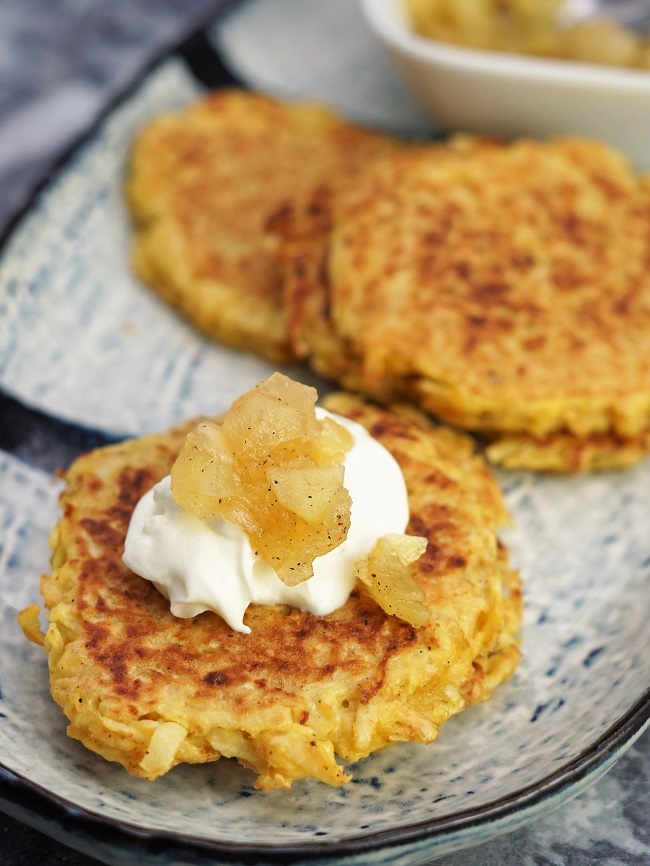
In this post I’ll also show you how to make a sweet-tart apple relish to serve on top of Celeriac Latkes.
Perfect with a dollop of thick yogurt or soured cream too.
Jump to Recipe
I wasn’t quite sure what to call this recipe. Pancakes? Rosti? Latkes? Hash browns even?
They’re all quite similar, being originally based on grated potato. Some have egg, onion and flour. Others just one of these. Some none of these additions.
But I finally settled on Celeriac Latkes partly because, of all those dishes mentioned, it was latkes that first got me into potato pancakes.
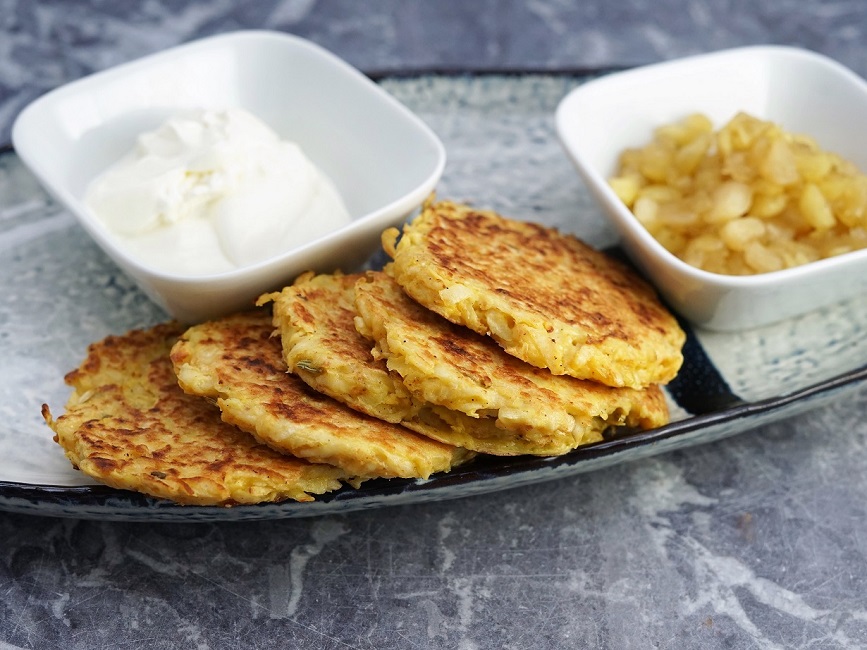
The other reason I’ve named them in this way is because the traditional accompaniments to latkes inspired the toppings for my celeriac version.
LATKES
Latkes are little fried pancakes usually made with grated potato. The word is Yiddish, and the eating of latkes is most associated with the Jewish festival of Hanukkah.
The history of latkes, and why they’re eaten on Hanukkah, is an interesting one. Read about it here.
I think I first made potato latkes back in the nineties when I got my copy of Oded Schwartz’s In Search of Plenty: A History of Jewish Food.

I also learned from that book that latkes, besides accompanying meat dishes, are often eaten with apple sauce and sour cream.
While I’m more likely to eat eggs with my potato latkes, for my celeriac version I thought apple in some form, plus something creamy, would be perfect.
By the way, don’t go thinking I can’t call my pancakes latkes if they don’t contain potato.
Latkes made from all sorts of vegetables (and other ingredients such as cheese) were around a long time before potatoes were first brought from the New World to Europe and beyond.
For all those reasons, I’m happy to call these delightful little pancakes Celeriac Latkes.
CELERIAC
In my view, celeriac is one of those vegetables that really should be on more British dinner tables. And it’s in season right now.
To some, I guess its gnarly, knobbly appearance may seem rather unattractive. Especially compared to those uniform, more familiar vegetables in the supermarket.
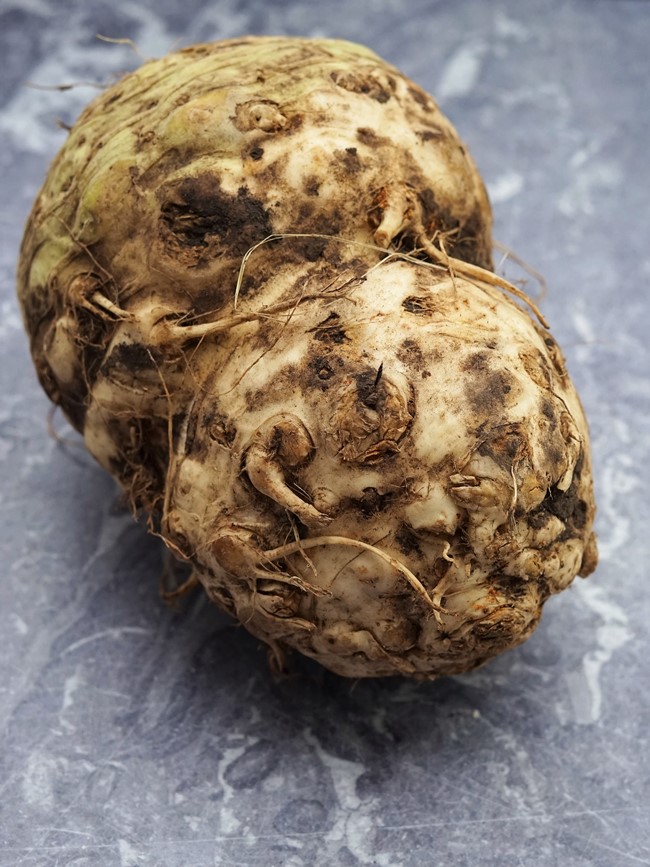
But I think there’s something beautiful in the celeriac’s ugliness.
Okay, the one shown here, from a recent Moorland Veg Box delivery, does look some alien lifeform.
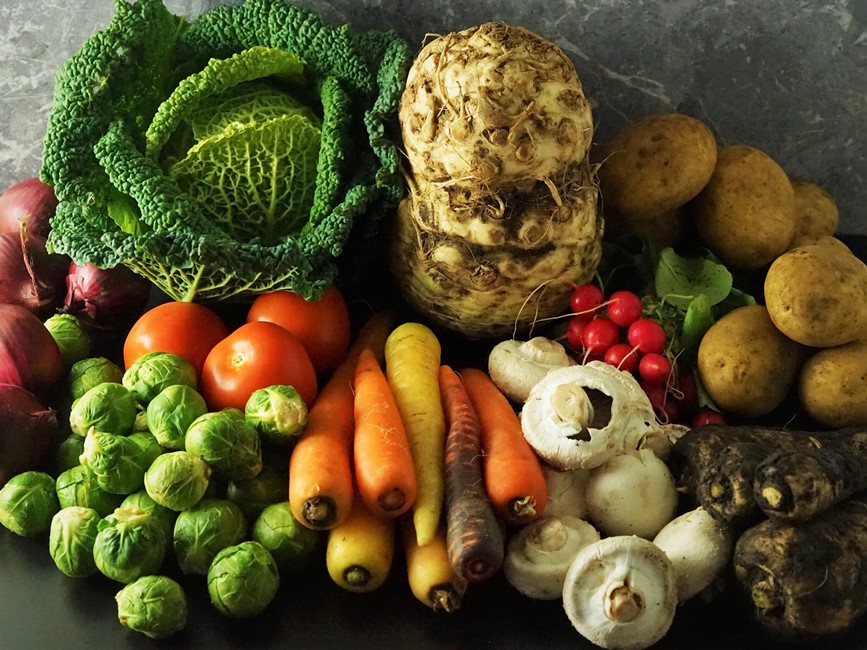
But, to me anyway, there’s something wonderful about it. Call it character if you like.
The important thing though, is that beneath its unprepossessing exterior, lies a wonderful vegetable.
The flavour of celeriac has been likened to a combination of celery and parsley, although I think it’s more subtle than either of those.
Developed from the root of wild celery, celeriac has apparently been eaten in Europe since ancient times.
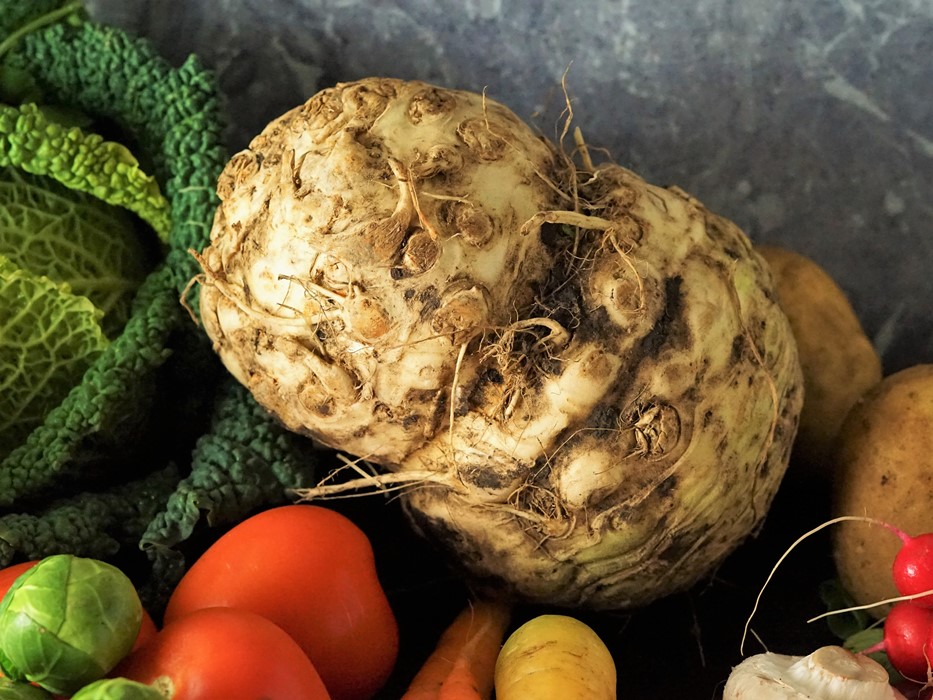
If you’ve heard of only one celeriac recipe, then it’s likely to be remoulade: a French, coleslaw-like dish with a mustardy dressing.
Crunchy and nutty eaten raw, celeriac becomes beautifully smooth when cooked. Hence its popularity as a puree on cheffy menus.
Looking for a lower carb alternative to potatoes? Celeriac fits the bill with less than half the carbs of potatoes.
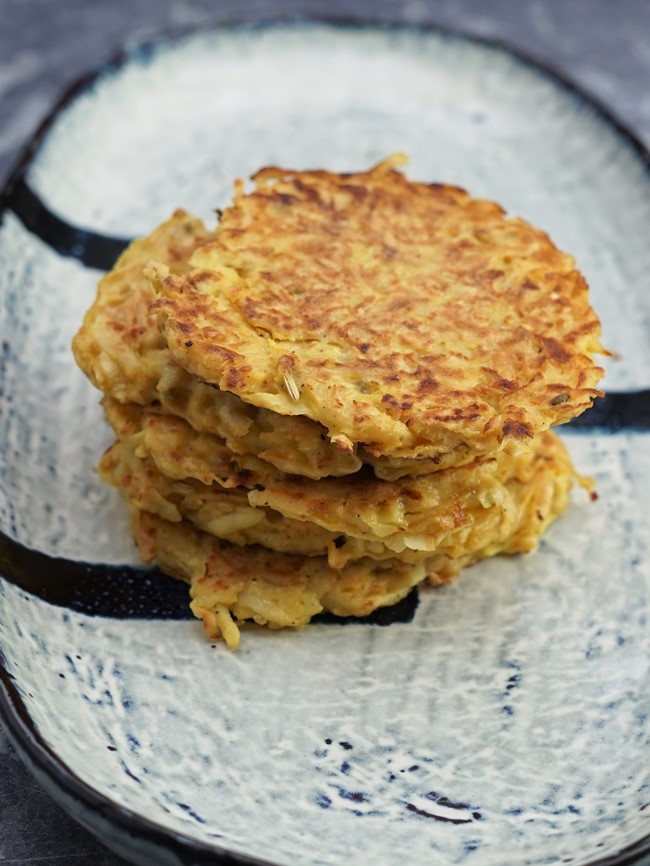
Although the recipe I want to share with you today is simple, it’s surprisingly good.
CELERIAC LATKES
One thing many celeriac recipes will tell you to do is put the peeled celeriac in water that’s had lemon juice added. This is to stop the celeriac going brown.
However, we’re not going to bother. The latkes will turn appetisingly golden in the pan or griddle anyway, so no one will notice.
What we will do though is start off extracting some of the vegetable’s water.

The grated celeriac, along with some onion, is put into a sieve and mixed with a little salt.
Left for 20-30 minutes, this will draw out a lot of liquid which would otherwise make our latkes too wet.
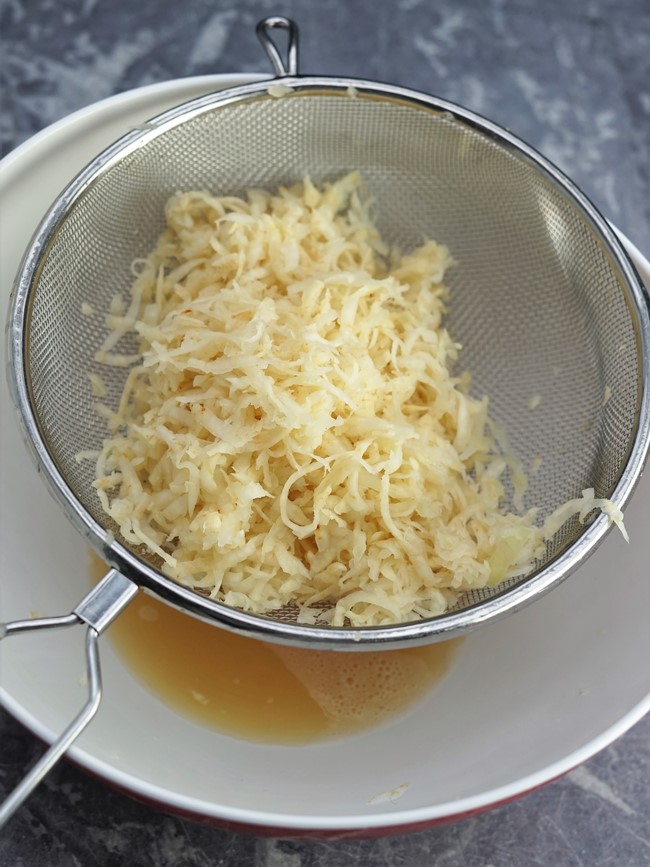
Actually, you might be surprised at just how much water comes out.
Even more will come out when you squeeze it (using your hands or twisting in a clean cloth) to get the vegetables as dry as possible.
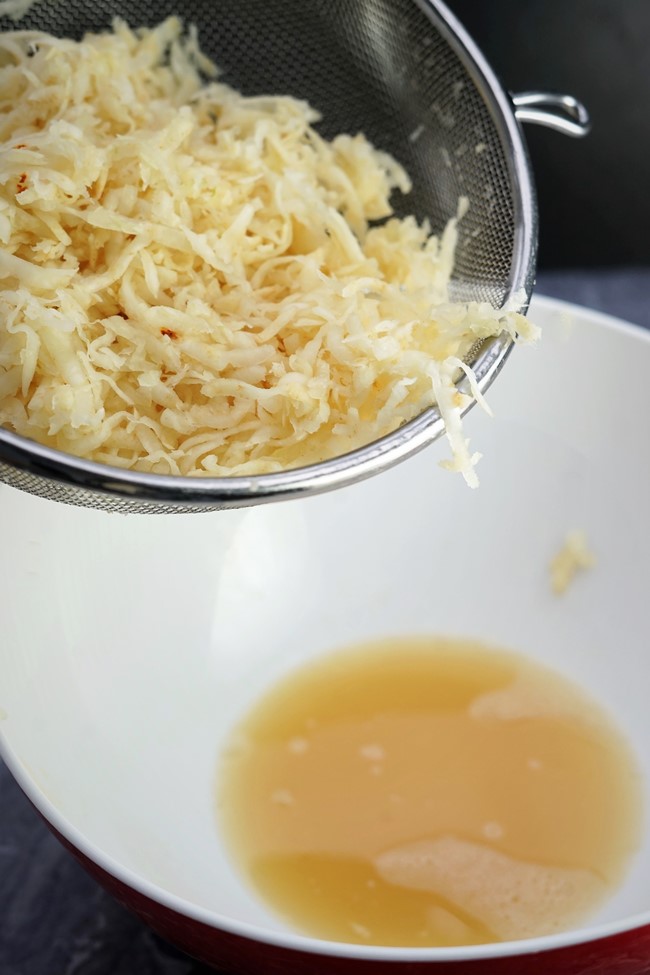
Incidentally, although your heap of grated celeriac may look way too much at the beginning, don’t worry. Due to this water extraction, you’ll find you end up with a manageable amount in the end.
As a rough guide, a small to medium celeriac weighing 400-500g before peeling and prepping will make around six large or twelve small latkes.
Next, the vegetables are mixed with a couple of tablespoons of plain flour, two beaten eggs and some seasoning.
Traditionally, caraway seeds are added to latkes, but I prefer fennel seeds. I lightly crush them with the back of a teaspoon before adding them along with a little salt and lots of freshly ground black pepper.
COOKING THE LATKES
Once all the ingredients are combined, get cooking the Celeriac Latkes straight away. What we don’t want is the vegetables to release any more moisture.
I use my electric griddle, lightly greased, to cook the latkes. But you can use a frying pan and shallow fry them, a few at a time if necessary.
Traditionally, if the latkes weren’t going to be eaten with dairy products, then the frying medium would have been rendered goose or chicken fat (schmaltz). But use whatever oil or fat you like.
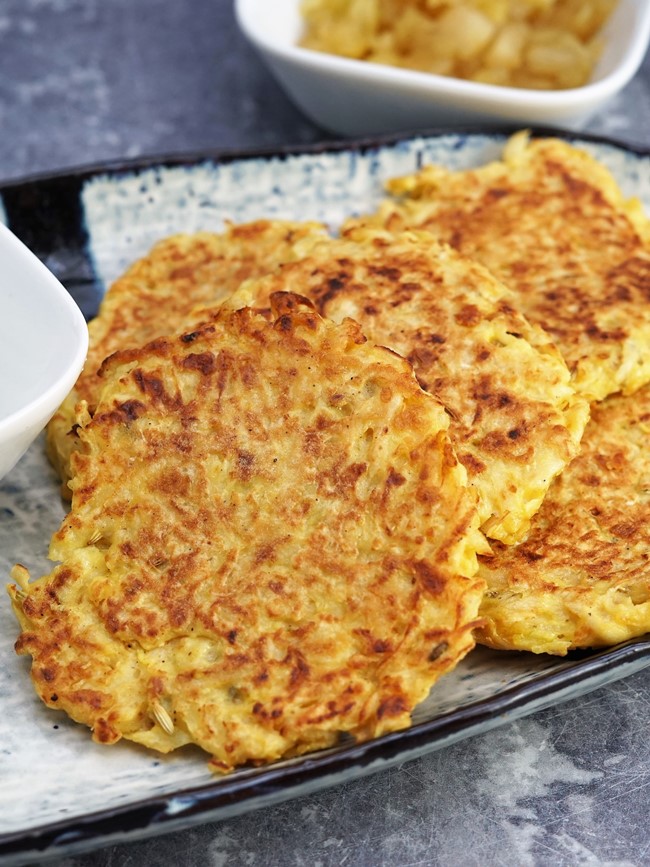
I use a tablespoon of mixture for each latke (a heaped tablespoon for larger ones), flattening it with a spatula.
Depending on how thick you make yours, Celeriac Latkes should take around 3-5 minutes per side to cook through and get a golden exterior.
They’re best eaten straight away. But, once cooled, you can store them in the fridge for 2-3 days. Reheat in the pan, griddle or a low oven.
Some people do freeze latkes, although I’ve never tried it.
SERVING CELERIAC LATKES
As I’ve mentioned, one popular way of serving potato latkes is to top them with soured cream and apple sauce. I thought these flavours would go well with celeriac’s nutty earthiness too.
APPLE RELISH
But I knew I didn’t want an overly sweet, smooth apple sauce so decided to put my own spin on it. The result was what I call Apple Relish.
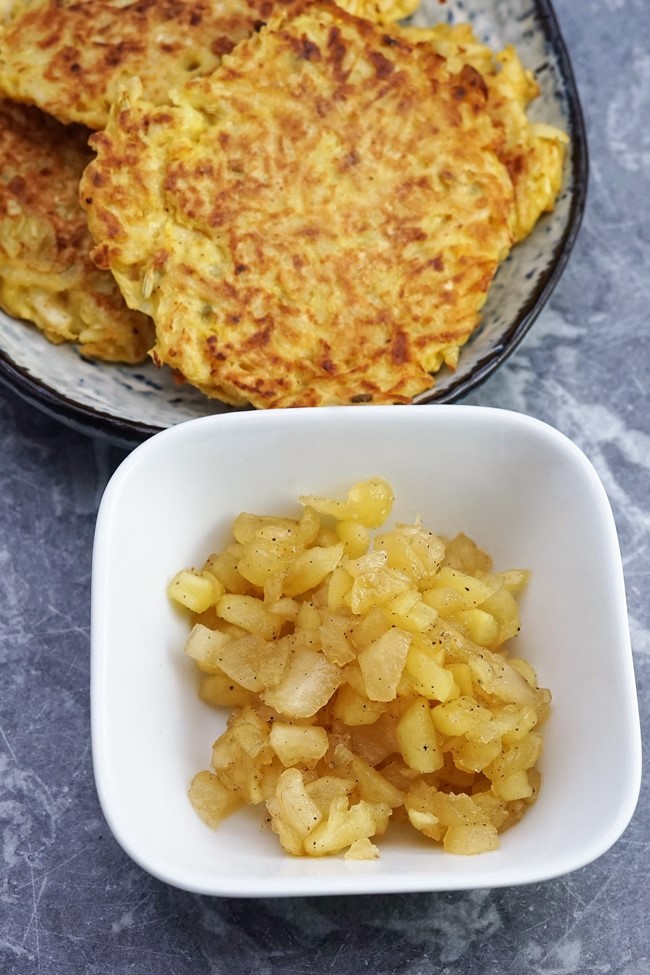
Wanting the apples to hold their shape rather than completely break down, I used eating apples instead of cooking apples like Bramleys.
To bring tartness and not just sweetness, I simmered the diced apple in equal quantities of cider vinegar, sugar and water.
It doesn’t take long to cook the Apple Relish. It’s ready when all the liquid has evaporated and the apple is tender rather than crunchy.
I made the relish while the salted vegetables were draining their liquid, seasoning with a little salt and pepper when done.
The relish is best eaten at room temperature, so just set aside until needed.
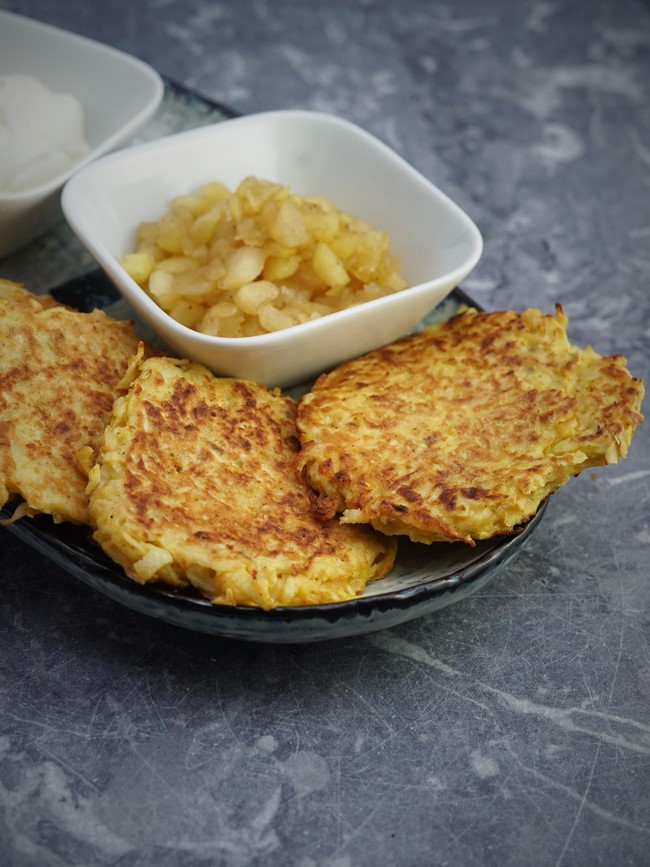
Instead of the traditional sour cream with apple, I paired the relish with yogurt.
CREAMY
I almost always have Homemade Yogurt in the fridge, strained so it’s thick, Greek style. But by all means use sour cream or creme fraiche if you have it.
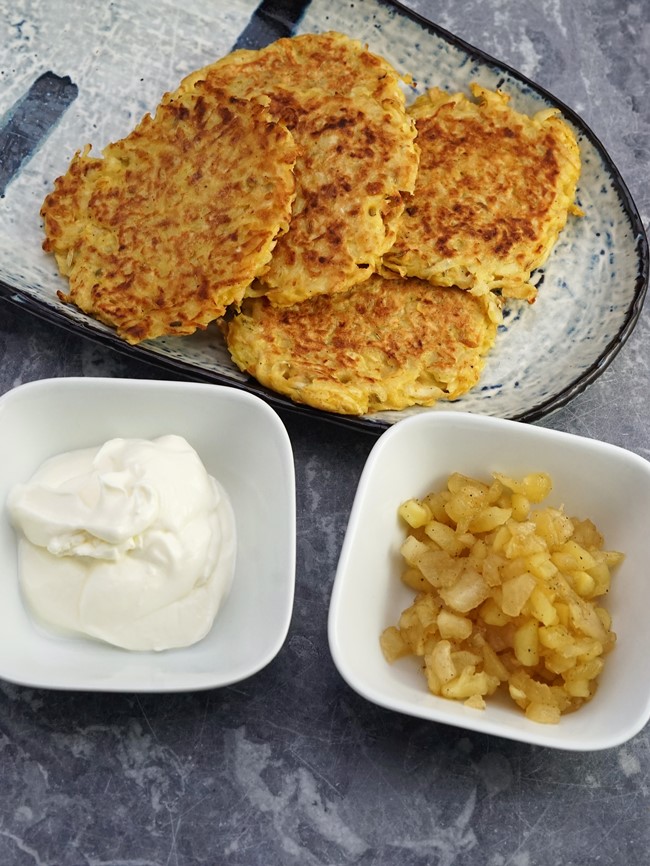
The combination of earthy Celeriac Latkes, creamy yogurt and sweet-tart apple relish was incredibly good.
Far better than I’d hoped, in fact.
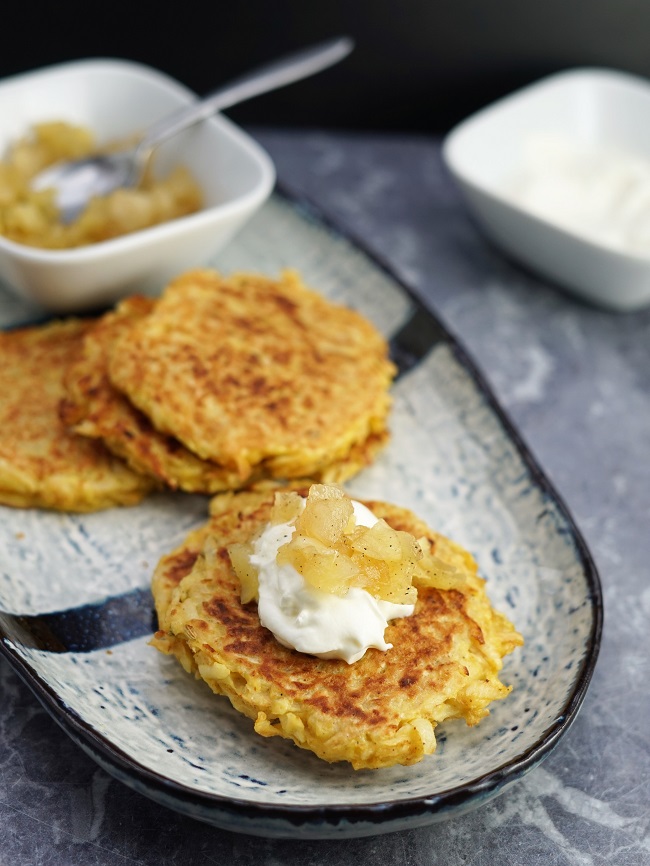
We ate this batch for brunch, but they’d make a great starter or snack.
Of course the toppings, although highly recommended, are entirely optional.
Celeriac Latkes can be eaten as you might any potato pancake, hash brown or similar: serve as a side to a main meal, as part of a big breakfast or simply top with poached eggs.

However you eat them, I hope you’ll agree that Celeriac Latkes are a great way to use this underrated vegetable.
Have you made this recipe?
Leave a comment and don’t forget to rate it.

Celeriac Latkes with apple relish
Celeriac Latkes are a great alternative to the traditional savoury pancake made with potato.
Serve as a side dish or as an appetizer or snack topped with yogurt or soured cream and a sweet-tart apple relish.
Ingredients
- 1 small celeriac 400 - 500g unpeeled
- 1 medium onion
- salt
- 1 tsp fennel seeds, lightly crushed
- 2 eggs beaten
- 2 tbsp plain flour
- black pepper
- oil or fat for frying or griddling
Apple relish
- 2 small eating apples
- 1 tbsp cider vinegar
- 1 tbsp brown sugar
- 1 tbsp water
- salt and black pepper
To serve
- yogurt, soured cream or creme fraiche
Instructions
-
Peel away the celeriac's thick skin using a sharp knife. Make sure you peel away enough to remove any brown circles made by its roots.
Rinse under a cold tap.
-
Coarsely grate the celeriac and put it into a fine sieve over a large bowl.
Skin the onion and finely grate it. Add it to the celeriac in the sieve.
Sprinkle the vegetables with a large pinch of salt and toss together with your hands.
Leave for 20-30 minutes: water will be released that would otherwise make the latkes too wet.
-
Meanwhile, make the Apple Relish.
Peel, core and chop the apples into small dice.
Place in a small saucepan with the vinegar, sugar and water.
Bring to a boil, then turn down the heat and simmer until the apples are tender but not falling apart and the liquid has evaporated.
Taste and season very lightly with salt and pepper, adding a little more sugar if liked.
Set aside to cool while you make the latkes.
-
Take handfuls of the celeriac/onion mixture and squeeze out as much liquid as you can.
Alternatively: put in a clean cloth and twist out the water.
When as dry as possible, put the vegetables into the rinsed and dried bowl.
Add the fennel seeds, beaten eggs and plain flour to the bowl.
Season with a little salt, lots of black pepper, then mix together well with a spoon.
-
Put a frying pan or griddle over medium heat. Add oil for shallow frying or lightly grease the griddle.
Take tablespoons of the mixture (heaped tablespoons for large latke) and put them in the hot oil. Flatten with a spatula to make round pancakes. Do this in batches if necessary, adding more oil or fat as needed.
Cook on both sides until golden brown (approx 3-5 minutes per side).
-
Serve the warm Celeriac Latkes with a dollop of yogurt, soured cream or creme fraiche and a teaspoon of Apple Relish.
Without the toppings the latkes with keep for 2-3 days and can be reheated in a pan, griddle or low oven.

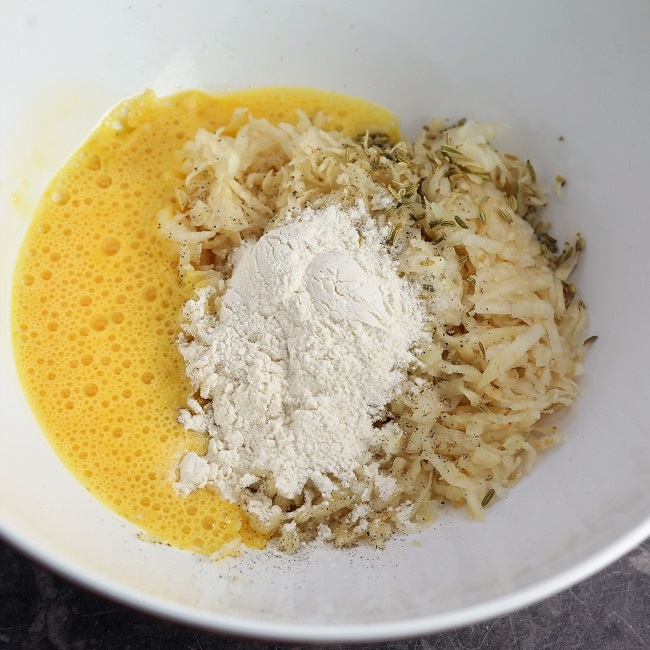

Hi. Can these be cooked in an air fryer? I’m trying to reduce my use of oil. Thanks.
Hi Linda, I’m rather new to air fryer cooking so haven’t tried these in one. I’d like to think they would work so long as you brush/spray liberally with oil. Do let me know if you give it a go!
These are absolutely delicious! The recipe is very easy to follow and took minutes to prepare. The flavour is more subtle that you might expect with both celeriac and fennel seeds but it works. We had them with some leftover Lamb Rogan curry and they were a nice foil to the spiciness. A perfect use for that celeriac that seems to always outlast the rest of the veg box!
Thanks for the lovely feedback, Angela! So pleased you enjoyed the Celeriac Latkes and found them quick and easy to make.
I like the sound of eating them with curry: I would never have thought of that!